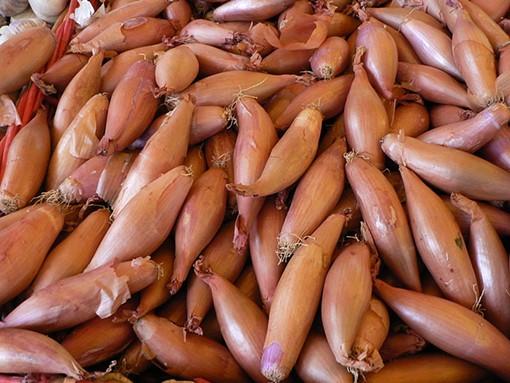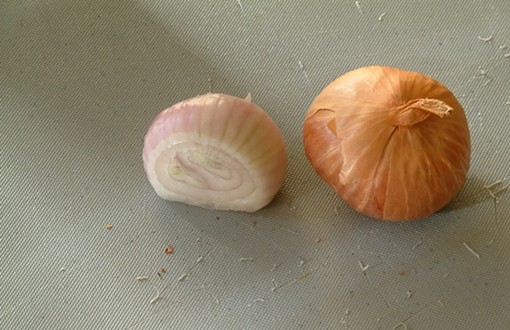In his bestselling memoir, Kitchen Confidential, Anthony Bourdain lists as the first necessary food item in the chapter titled "How to Cook Like A Pro" -- before butter, my friends -- the humble shallot. He writes, "You almost never see this item in a home kitchen, but out in the world they're an essential ingredient. Shallots are one of the things -- a basic prep item in every miss-en-place -- that make restaurant food taste different from your food. In my kitchen, we use nearly twenty pounds a day."
I need no better persuasion than the words of the ubiquitous Mr. Bourdain. Since reading his book years ago, I've incorporated shallots into my reliable pantry staples, and if you're learning how to cook from scratch, you should, too. Think about how fancy that makes you sound! If someone asks you what's in a certain dish, what screams "I know what I'm doing" better than tossing the term shallot around casually.
Shallots look like small onions, though they have clustered cloves, like a bulb of garlic, and reddish-brown skins. They're usually found with potatoes, garlic and onions in the produce section. Novice foodies just getting into cooking might overlook shallots for their allium cousins, the mighty onion and garlic, but that would be a grave mistake.
While most days I've got garlic on my breath (just ask my husband), and I do cook with onions, the shallot has proven to be an aromatic workhorse in my kitchen. I use them when cooking for my onion-hating husband because they lack the sharp bite of a white onion but still provide pungency (albeit subtler), and I employ them whenever I want more depth of flavor, as they are sweeter, yet milder, than onions. They're also smaller than onions -- perfect for recipes that call for only a tablespoon or two.
This week I craved a simple comfort meal: grilled cheese and tomato soup. I used Mark Bittman's basic tomato soup recipe, which he encourages cooks to modify to their own tastes. So for the recipe's mirepoix, I used shallots in place of onions. Not only did the shallots provide an ethereal tang, but their sweetness tempered the acidity of the tomatoes, balancing the entire bowl. It was a dish that I'll make for the rest of my life, and it would have been just another bowl of soup had it not been for shallots.
I stuff the cavity of roasted chicken with shallots, and I've also caramelized them down into a sort of marmalade topping for puff pastry squares or bruschetta. You can even fry them like onion rings and use them as a savory dish topping, like green bean casserole. If you've never done so, pick some up. Their versatility means you're bound to use them one place or another, and I've never regretted adding them to a dish.
Kelli Best-Oliver is on a quest to become a full-fledged foodie. She chronicles her adventures every Tuesday. She writes about any damn thing she pleases at South City Confidential.
The Novice Foodie Sheds Tears of Joy for the Humble Shallot
[
{
"name": "GPT - Leaderboard - Inline - Content",
"component": "41932919",
"insertPoint": "5th",
"startingPoint": "3",
"requiredCountToDisplay": "3",
"maxInsertions": 100
}
]







